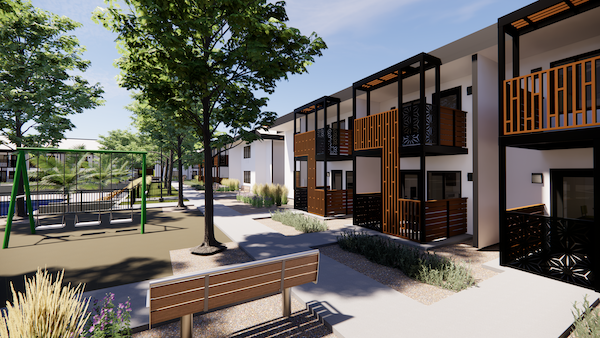
The elevation for Dakota, Fresno. Image contributed
Written by Paul Halajian Architects
Urban infill projects and rehabilitation of blighted buildings can add measurable value to communities, and the development of affordable housing development can be a catalyst for urban revitalization.
Several cities in the Central Valley are among the top 17% of the most expensive cities in the world, with the average cost of living in Fresno at $2,083 per month. As housing costs are the largest of those expenses, the development of affordable living options is crucial to support those households with low to middle income, families with special needs, disabled veterans, and seniors living on fixed incomes.
Many urban parcels are often underutilized or not developed to their fullest potential. This is where affordable housing can be most transformative. Increasing local tax revenue and improving the local economy are just some of the benefits this housing type fosters, and thoughtful architectural design can play a pivotal role in countering negative stigma and enhancing property values.
Construction financing for affordable housing development often leverages multiple funding sources including commercial lending, federal Low-income Housing Tax Credits, tax-exempt bonds, state tax credits and public subsidies. The public subsidy is often the first funding committed allowing the project to move forward while other sources are identified.
One notable initiative exploring this idea is the Better Blackstone Design Challenge. The Blackstone Corridor, known as Fresno’s “backbone,” connects six council districts and is the main artery for the Bus Rapid Transit system that connects North Fresno to Downtown. Paul Halajian Architects (PHA) was one of several local firms to explore the possibilities of overlaying affordable and mixed-income housing with other use types to create vibrant and economically profitable development.

Emerging as a Valley leader for affordable housing design, PHA partnered with developers UPholdings and RH Community Builders on two of the catalyst projects for the Better Blackstone Design Challenge – Crossroads Village and The Dakota.
Crossroads Village is an adaptive reuse project converting the former blighted Smuggler’s Inn into 143 affordable multifamily housing units. PHA embraced the challenges inherent in rehabilitation projects and innovatively developed a “jigsaw puzzle plan” approach for the ground-level units, which not only removed the dismal corridor but repurposed that square footage back into the units as usable storage space. The clients desired a contemporary look, but recladding the buildings was cost-prohibitive. PHA instead capitalized on the local requirement for balconies and transformed the aesthetic through the new balcony design.
The Dakota, adjacent to Crossroads Village, will be developed on the site of the former Smuggler’s Restaurant. This new 4-story building will provide 114 affordable units and is designed to be zero net energy – a design strategy in which the amount of energy produced, usually through solar panels, is equal to the amount of energy the building uses. The building design carefully wraps around a 50-year-old Cork Oak tree – one of the largest specimens in Fresno – acknowledging its significance in the urban fabric.
Other notable affordable housing projects in the Valley designed by PHA include Esperanza Village in downtown Madera (with The Pacific Companies), La Joya Commons in Firebaugh (with Fresno Housing Authority), and Rancho Colegio in Visalia (with Self-Help Enterprises).
Through thoughtful design, innovative solutions, and the use of state-of-the-art technology, Paul Halajian Architects is committed to improving the cultural, social, and physical context of the Central Valley.








